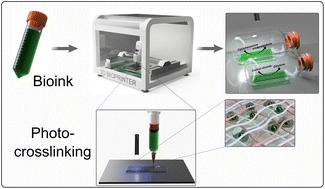当前位置:
X-MOL 学术
›
Green Chem.
›
论文详情
Our official English website, www.x-mol.net, welcomes your feedback! (Note: you will need to create a separate account there.)
Employing photocurable biopolymers to engineer photosynthetic 3D-printed living materials for production of chemicals
Green Chemistry ( IF 9.8 ) Pub Date : 2024-02-29 , DOI: 10.1039/d3gc04264b Gábor Szilveszter Tóth 1 , Oskar Backman 2 , Tiia Siivola 1 , Wenyang Xu 2 , Sergey Kosourov 1 , Vilja Siitonen 1 , Chunlin Xu 2 , Yagut Allahverdiyeva 1
Green Chemistry ( IF 9.8 ) Pub Date : 2024-02-29 , DOI: 10.1039/d3gc04264b Gábor Szilveszter Tóth 1 , Oskar Backman 2 , Tiia Siivola 1 , Wenyang Xu 2 , Sergey Kosourov 1 , Vilja Siitonen 1 , Chunlin Xu 2 , Yagut Allahverdiyeva 1
Affiliation

|
Photosynthetic microorganisms, such as cyanobacteria and microalgae, have great potential as living cell factories for chemical and fuel production. Immobilisation of cells is an effective technique for enhancing productivity and longevity of the production system, as well as aiding in the separation of cells from the medium. Alginate crosslinked with divalent ions is commonly used for immobilisation, however its ionic crosslinking is reversible in high ionic strength or in the presence of chelating agents leading to matrix degradation. To address these challenges, photocurable materials present a potential solution, especially when coupled with 3D-printing technologies to create complex, tunable 3D architectures for various applications. In this context, we propose a bioink composed of alginate, photocurable galactoglucomannan-methacrylate and photosynthetic cells for 3D-printing green biocatalysts for solar-chemical production. We demonstrate the applicability of this photocurable bioink for the immobilisation of photosynthetic microbes either capable of producing ethylene (specifically-engineered Synechocystis cell factories) or transforming cyclohexanone to ε-caprolactone (specifically-engineered Chlamydomonas cell factories), both of which are industrially relevant chemicals. Films produced from photocurable bioinks demonstrate high mechanical stress tolerance compared to films prepared via conventional ionic crosslinking, showing resistance to high ionic strength in the medium. Furthermore, both Synechocystis and Chlamydomonas cells entrapped within 200 μm-thick hydrogel layers, 3D-printed on glass support surfaces, demonstrated notably high (ethylene) or similar (biotransformation of cyclohexanone to ε-caprolactone) production titres and space–time yields compared to the conventional biocatalysts. These engineered living materials, being biocompatible and biobased, particularly when used in conjunction with 3D-printing, provide convenient scalability and potential to enhance sustainability in the chemical industry.
中文翻译:

采用光固化生物聚合物设计用于生产化学品的光合 3D 打印活性材料
光合微生物,例如蓝藻和微藻,作为化学和燃料生产的活细胞工厂具有巨大的潜力。细胞固定化是一种有效的技术,可提高生产系统的生产率和寿命,并有助于从培养基中分离细胞。与二价离子交联的藻酸盐通常用于固定化,但其离子交联在高离子强度下或在螯合剂存在下是可逆的,导致基质降解。为了应对这些挑战,光固化材料提供了一种潜在的解决方案,特别是与 3D 打印技术相结合,为各种应用创建复杂、可调的 3D 架构。在此背景下,我们提出了一种由海藻酸盐、可光固化的半乳葡甘聚糖-甲基丙烯酸酯和光合细胞组成的生物墨水,用于3D打印用于太阳能化学生产的绿色生物催化剂。我们证明了这种光固化生物墨水对于固定光合微生物的适用性,这些微生物能够产生乙烯(专门设计的集胞藻细胞工厂)或将环己酮转化为ε-己内酯(专门设计的衣藻细胞工厂),这两种微生物都是工业相关的化学品。与通过传统离子交联制备的薄膜相比,由光固化生物墨水生产的薄膜表现出较高的机械应力耐受性,表现出对介质中高离子强度的耐受性。此外,与 3D 打印在玻璃支撑表面上的 200 μm 厚的水凝胶层中捕获的集胞藻和衣藻细胞相比,它们表现出显着高的(乙烯)或类似的(环己酮生物转化为 ε-己内酯)的生产滴度和时空产率。传统的生物催化剂。这些工程活性材料具有生物相容性和生物基性,特别是与 3D 打印结合使用时,可提供方便的可扩展性和增强化学工业可持续性的潜力。
更新日期:2024-02-29
中文翻译:

采用光固化生物聚合物设计用于生产化学品的光合 3D 打印活性材料
光合微生物,例如蓝藻和微藻,作为化学和燃料生产的活细胞工厂具有巨大的潜力。细胞固定化是一种有效的技术,可提高生产系统的生产率和寿命,并有助于从培养基中分离细胞。与二价离子交联的藻酸盐通常用于固定化,但其离子交联在高离子强度下或在螯合剂存在下是可逆的,导致基质降解。为了应对这些挑战,光固化材料提供了一种潜在的解决方案,特别是与 3D 打印技术相结合,为各种应用创建复杂、可调的 3D 架构。在此背景下,我们提出了一种由海藻酸盐、可光固化的半乳葡甘聚糖-甲基丙烯酸酯和光合细胞组成的生物墨水,用于3D打印用于太阳能化学生产的绿色生物催化剂。我们证明了这种光固化生物墨水对于固定光合微生物的适用性,这些微生物能够产生乙烯(专门设计的集胞藻细胞工厂)或将环己酮转化为ε-己内酯(专门设计的衣藻细胞工厂),这两种微生物都是工业相关的化学品。与通过传统离子交联制备的薄膜相比,由光固化生物墨水生产的薄膜表现出较高的机械应力耐受性,表现出对介质中高离子强度的耐受性。此外,与 3D 打印在玻璃支撑表面上的 200 μm 厚的水凝胶层中捕获的集胞藻和衣藻细胞相比,它们表现出显着高的(乙烯)或类似的(环己酮生物转化为 ε-己内酯)的生产滴度和时空产率。传统的生物催化剂。这些工程活性材料具有生物相容性和生物基性,特别是与 3D 打印结合使用时,可提供方便的可扩展性和增强化学工业可持续性的潜力。



























 京公网安备 11010802027423号
京公网安备 11010802027423号